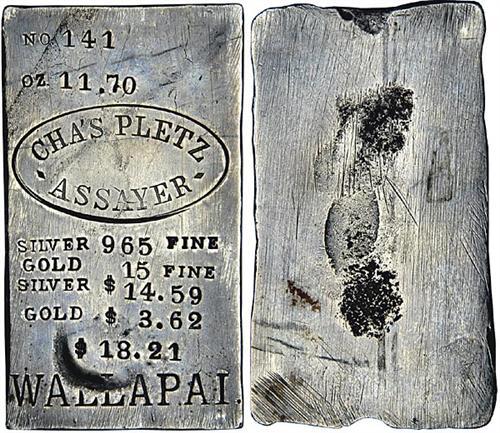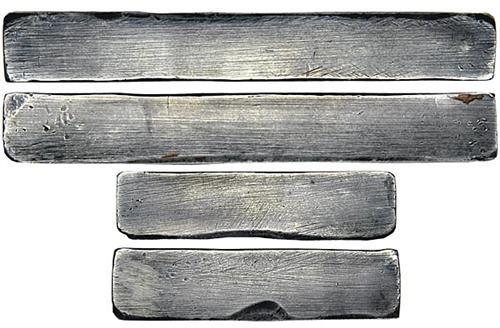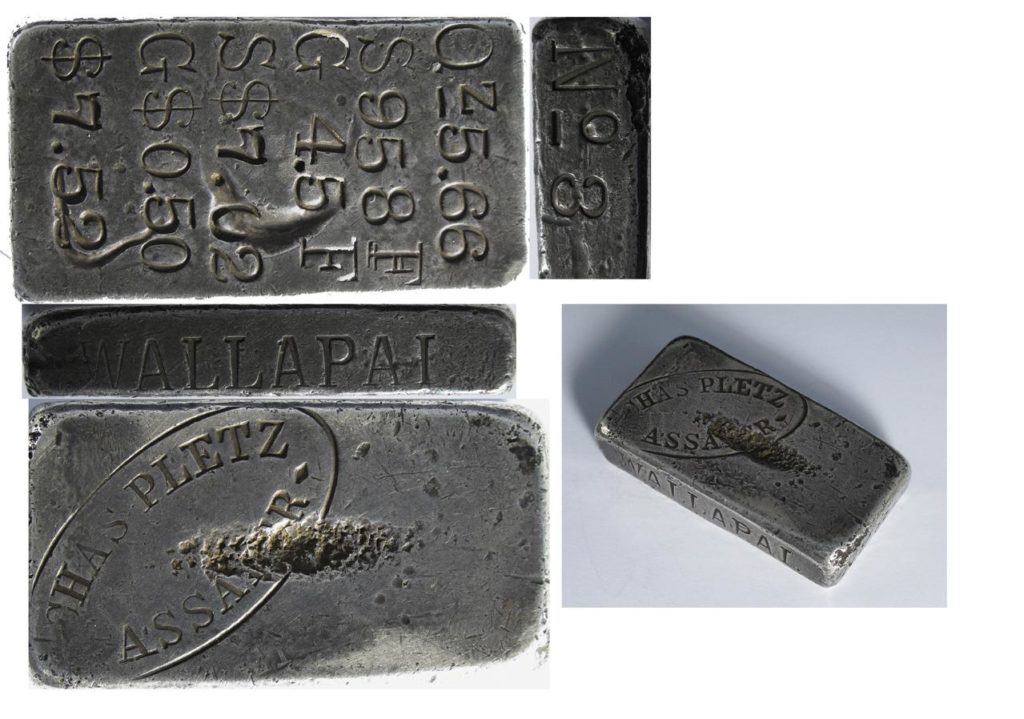Wallapai Mining District, Cerbat Mountain, Mohave County, Arizona
Very little is recorded of Charles Pletz beyond a few bare notices in Arizona’s Weekly Miner newspaper of the mid-1870s (all of which were provided to Mr. Ford by the Sharlot Hall Historical Society). The paper’s issue of May 14, 1875 notes Pletz as superintendent of the Mass Mine while the following June 4 the paper notes Pletz’ interest in mining in the Mineral Park District. For July 9, 1875 the paper stated that Pletz would operate a mining mill at Mineral Park. The issue of October 22, 1875 noted that Pletz had opened an assay office, location not noted. On July 14, 1876 the paper reported that Pletz was to be named supervisor of the Quartz Mounting Mill. On November 17, 1876 the same paper noted Pletz as assistant assayer of the Aztlan Mill and on March 9 of the following year reported that Pletz had sold an interest in the Everett Mine. The last mention of Pletz known to the cataloguer is a notice in the Miner of November 9, 1932, that describes a place in the Cerbat Mountain where a certain Jack Flynn dug out several hundred pounds of silver ore, samples of which assayed out at Pletz’ assay office at more than $3,000 a ton.
A Bavarian Hairdresser Comes to the California Gold Rush
Charles Pletz was born in Bavaria in 1837. He and his wife Margaret came to the United States for the California gold rush in the 1850’s. His early life in California is unknown, but by the late 1850’s, Pletz was living in San Francisco.
San Francisco’s first detailed residential Directory was published in 1860 by Henry Langley. Pletz’s occupation is listed as “ornamental hair work.” The same listing is present in the 1861 San Francisco Directory, but Pletz appears to have left San Francisco before data for the 1862 Directory was compiled. We also know from Federal census records that Pletz and his wife had a son born in 1861, who they named Charles Pletz, Jr.
Pletz Emerges as an Assayer
Between about 1862 and about 1868, Pletz may have caught the gold bug and headed into the gold fields. He is not found as a hair dresser in the 1867 Pacific Coast Business Directory, nor in San Francisco or Nevada Directories of this period. Just after that, he emerges in Dayton, Nevada as an assayer. The census data indicate his children were born in California through 1868, thus he may have been in a place such as Marysville working for a large assay firm, or in the foothill gold belt working for an assay firm or in a mill. Every mine and mill employed an assayer and assistants, and undoubtedly Pletz filled one of these positions somewhere. Regardless, Pletz emerged as a transformed hair stylist into a full-fledged mining man.
In 1863 and 1864 there were about 100 mills associated with the Comstock. Many were on the Carson River near Dayton, a few were in Dayton, and others in places nearby such as Gold Canyon. The Carson River was the largest and only regular source of water which was the most precious commodity for a mill. As time and mining progressed, milling of Comstock ores became centralized along and near the Carson River. By 1870, Comstock mining financiers John Mackay and James G. Fair controlled most of the large mills. There were about 25 active producing mills in the area in 1870-1871, according to Henry Whitehill in the Biennial Report of the State Mineralogist of the State of Nevada for the Years 1871-1872. Many of the workers for these mills lived in Dayton, Empire, and other communities central to the mill operations. Three of these mills were in Dayton proper, and five more were in Gold Canyon nearby. The three in Dayton were the Birdsall & Co., Reservoir and Rock Point mills. The first two processed tailings, and the Rock Point mill processed ore and tails, but was idle in 1871. The Birdsall mill was the largest by far, with a capacity of 300 tons per day.
When the 1870 Census was taken, the census worker canvassed Dayton by going door to door. This allows for added interpretation of the original census data filled out by the census worker. Just before Pletz’s name in the census is that of John Rawlings, a quartz mill worker. This suggests that Pletz and Rawlings were in an office of a milling company. The next names were that of William Gates, a lawyer, followed by a saloon keeper. The obvious suggestion of the data is that the census worker went to a mine office, a law office and a saloon, in order, as he progressed down a street in Dayton. The lack of a newspaper published in Dayton, accompanied by the lack of specific data in the directories does not allow for the interpretation of which company Pletz worked. It does allow for the interpretation that he was not an independent assayer, since the business directories within the residential directories show only one commercial assayer, Harvey Harris up in Silver City.
Arizona Territory Silver
Discoveries of massive silver deposits at the Comstock, Treasure Hill, Reese River and other places in Nevada, coupled with a major discovery in Utah at the Ontario mine, later controlled by George Hearst, fueled western exploration for more of the precious metal. Prospectors reached out to areas once thought untouchable. Soon the desert mountains of Arizona crawled with prospectors. It wasn’t long before, in the 1860’s, that the Apaches controlled the land with ruthless authority. Early mines had been ransacked, and many killed during the pursuits of the all-mighty ore deposits. Perhaps some of the best known events illustrating the Indian attacks were recorded by mining Engineer Raphael Pumpelly, whose memoirs note the killing of several mine workers near the Heintzelman mine. In the years after the Civil War, the Government established forts and outposts for the protection of westward expansionists. With this new-found protection came development of natural resources and attendant settling of the land.
The Hualapai, or Wallapai Mining District
The Hualapai district in the western slope of the Cerbat Range in Mojave County, Arizona was discovered in 1864, but work there abruptly stopped “on account of the hostility of the Indians, who killed several miners and drove away the rest,” according to Ross Raymond in Mining Statistics West of the Rocky Mountains. Most of the original claimants never came back, and mineral locations were restaked, and general prospecting took place again by about 1870, when about a dozen “white men” re-occupied the nearly lost district. Hualapai was one of the older Arizona districts, since it was only about 30 miles from the Colorado River at Hardyville, an area explored and prospected for placer gold.
By 1871 reports of rich gold and silver ore were hitting the San Francisco press, and undoubtedly the news was reaching the Comstock. One 100 ton shipment of ore to San Francisco yielded $800 per ton, as reported by Raymond. The first mill in the district was completed in early 1872, which was a five stamp mill.
As more prospectors found ores, the district grew. Mining camps popped up, such as Mineral Park and Parkerville (1871). News of the rich ores brought more prospectors and miners. With it came the ancillary socio-political change emphasized by the Anglicization of the Native American word Hualapai to its English phonetic pronunciation Wallapai. Hualapai is a Yuma Indian word meaning “pine tree folk”.
The early mill was a failure, with a recovery of only 30-50 percent. Smelters were built and other mills planned. Then a funny thing happened. As miners hit the water table in shafts, the value of ore dropped to practically nothing. Fearing the worst, many left the district in late 1872. But persistent miners continued onward, dropping shafts further deeper, until it was realized that there was a zone of barren mineralized rock ten to fifteen feet thick at the water table interface, and below that point, the ores became silver rich. By early 1873, the rush and boom were fully invigorated. One of the key mines was the Cupel (named after the cupel used in the assay process to reduce the ore sample to a gold-silver bead).
Pletz and Wallapai
The onset of high grade silver ore production clearly drew the attention of Charles Pletz. He left the Comstock for Mineral Park, by now not only the largest mining camp in the Wallapai district, but the Mojave County seat as well. Here he worked with mines to reduce ores, and probably produced this ingot in 1873 for use in promotion of the district in San Francisco, the center of western mine finance.
The ores were difficult to mine below the water table, difficult to reduce and smelt the argentiferous galena, and soon the district suffered from a lack of advanced technology to fully process the ores. Unfortunately, this was typical of many western mining districts, who suffered greatly until technology caught up. In many cases it was fully one hundred years before heap-leach technology allowed for economic ore reduction, and Mineral Park was no exception. The district became a major open pit mine in the latter quarter of the twentieth century.
Pletz appears to have left Arizona and America by 1880. Mineral Park had shrunk to a town of less than 15 merchants, with a single assayer W. A. Langley. Pletz and his family were never again a part of an American census, and the family perhaps moved back to Bavaria for a more steady life in less harsh surroundings. The legacy he left is this silver ingot, imparting the story of an emigrant becoming part of the California gold rush, and moving into the western mining frontier as an assayer in difficult conditions. It is a quintessential piece reflecting the opening of the West.
Charles Pletz, Assayer. Wallapai Mining District, Cerbat Mountain, Mohave County, Arizona. Silver and gold assay ingot number 141.


Overall appearance of Very Fine. Nice, medium silver gray color. Good stampings, minor puddling at the bottom of the face, cooling flaws incompletely polished away on the back, rearward edges imperfectly finished but others mostly sharp and presentable. The bar has been finished after cooling and was probably not meant to be melted or spent, but rather was made as a souvenir or keepsake.
There appear to be two other silver assay bars known stamped by Charles Pletz. Ingot number 235 was illustrated in How They Dug the Gold (Arizona Pioneer’s Historical Society, 1967). Mr. Ford contacted the bar’s owner, a Mr. Milton Singer of Bloomfield, Connecticut in August, 1973, asking, without success as it turned out, if the bar were for sale. In his letter to Singer, Mr. Ford mentioned he knew of one other Pletz ingot, bar number 141 (see lot to follow). Nearly five years later, on February 20, 1978, Mr. Ford made a second attempt to buy Singer’s Pletz ingot, this time offering $1,000 for it. Mr. Singer again declined to sell the bar, but sent Mr. Ford photographs of it for his files. Then, on December 17, 1979 Don Kagin received a letter from Mr. Singer asking if there was a Pletz bar in the Clifford Collection. Don forwarded Singer’s letter to Mr. Ford, who replied that there wasn’t and reminded Singer once again of Ford’s interest in buying Singer’s Pletz bar. Singer graciously declined once more, but offered Mr. Ford some information that helped locate Pletz’ assay office in Mohave County, Arizona. In December, 1984, Singer wrote Ford saying that his son wanted to have the Pletz bar, implying that it was thereafter “off the market”, but the bar appeared for sale in John Hamilton’s fixed price list offering published in the TAMS Journal in February, 1991.
In February, 1993 Hal Birt wrote Ford saying that Hamilton had brought the bar to the recent Tucson show. Its present whereabouts are unknown to the cataloguer and were to Mr. Ford. A third Pletz ingot is bar number 28, from the collection of the Sharlot Hall Historical Society in Prescott, Arizona. Paul Franklin brought the bar’s existence to Mr. Ford’s attention towards the end of 1979, a few months before Mr. Singer wrote to Don Kagin about Pletz. On September 14, 1979 Norm Tessman, Curator of Collections for the Society, sent photographs of their ingot to Franklin, and Paul forwarded them on to Mr. Ford. Ford replied immediately, asking for additional photographs and other information, particularly about assayer Frank Blake. A few months later, after Ford received Singer’s letter about Pletz’ Mohave County location, Ford wrote Tessman once again, repeating his earlier request. Tessman replied almost immediately, saying he had neglected Mr. Ford’s earlier request for information in part because “Quite frankly, I had just rejected Paul Franklin’s attempt to obtain the Pletz ingot and was slightly sour about what I perceived (again perhaps unjustly) as an attempt to take advantage of the Museum.” Tessman offered to make his research library available to Mr. Ford should a visit to the Society be thought worthwhile.
The ingot’s present whereabouts have not been ascertained. The Ford and Sharlot Hall Historical Society Pletz bars are similar in size, style, and layout. Both have their inscriptions arranged across the shorter dimension of the rectangular shape. On both, the bar number is first followed by the bar’s weight and the assayer’s logotype stamp (the same on both). Thereafter the two bars are somewhat dissimilar. On Ford’s the gold and silver finenesses and value are next whereas the Sharlot Hall bar has only its silver fineness and value. Since the Sharlot Hall bar’s fineness is given as 987, one wonders why Pletz felt it was unnecessary to indicate that bar’s gold fineness of .013 when on the Ford bar he stamped GOLD 15 FINE and on the Singer bar he noted GOLD 0.10 FINE. Another difference between the Ford and Sharlot Hall ingots is the absence of a location on the latter, which is given as WALLAPAI on Ford’s (and Singer’s) bar. Finally, both Ford’s and the Sharlot Hall’s Pletz bars have no inscriptions anywhere save on their faces. Like the Ford bar, Singer’s also states the location name but unlike Ford’s, does so on one long edge. Singer’s bar arranged its information partly along the short dimension of the rectangular shape, but after noting the bar’s number and weight, then changes to the long dimension to list the finenesses and values. In addition, on Singer’s bar the assayer’s logotype stamp, which is the same one seen on the Ford and Sharlot Hall ingots, is placed on the back of Singer’s and is partly obscured by the cooling depression there. All three Pletz ingots are small bars principally of silver with rather low values, $14.57 (Sharlot Hall), $11.25 (Singer), and $18.21 (Ford).
- Face: No. 141 / OZ. 11.70 / CHA’S PLETZ ASSAYER [in logotype within an oval outline] / SILVER 965 FINE / GOLD 15 FINE / SILVER $14.59 / GOLD $3.62 / $18.21 / WALLAPAI.
- Back: blank.
- Top edge: blank.
- Bottom edge: blank.
- Left edge: blank.
- Right edge: blank.
- Dimensions: 75.5 x 43.0 x 10.5 mm.
- Stated weight: 11.7 ozs.
From the John J. Ford, Jr. Collection
Provenance: Ex L.G. Barnard (Memphis, Tennessee) to P.B. Trotter before the summer of 1955. Seen at the Chase Money Museum in July, 1954. Offer made by New Netherlands Coin Company on August 5, 1954, declined. Offered to Morton Stack on September 6, 1955, declined. Seen by Mr. Ford at the 1955 ANA Convention in Omaha, believed at the time owned by P.B. Trotter. Sold by Trotter to Jerry Cohen at the Detroit Central States Convention on April 29, 1960 and thence by Cohen to Harry Forman. Sold by Forman to Art Kagin and by Kagin to Ford, date unrecorded. Mr. Ford’s informational card and photograph, together with photographs of the Singer no. 235 and Sharlot Hall no. 28 ingots, accompany the lot. Mr. Ford noted the actual weight of the bar as 11.5 ozs.
[10/2007] https://auctions.stacksbowers.com/lots/view/3-AV6NX/charles-pletz-assayer-wallapai-mining-district-cerbat-mountain-mohave-county-arizona-silver-and-gold-assay-ingot-number-141 ($51,750)
5.66 oz Wallapai,AZ – Mohave County – c1873 – Chas Pletz Silver Ingot, No 3

Front of ingot reads; OZ 5.66 /S 958 F / G 4.5 F / S $7.02 / G $0.50 / $7.52. Reverse is stamped Chas Pletz Assayer. 2 Sides are stamped Wallapai. One side is stamped No. 3. Measures 2″ X 3/8″ X 1″. This is one of only three known Pletz bars.
An Early Arizona Silver Ingot, circa 1873
[10/2010] https://www.icollector.com/Wallapai-AZ-Mohave-County-c1873-Chas-Pletz-Silver-Ingot-Discovery-Ingot_i9798860 ($28,200)
Missing Photos and information – 7.65 oz Charles Pletz Silver Ingot
Following description was found in the text for the previous ingot listed, but it is clearly a unique piece on its own. More research needs to be done to fill in the gaps along with photos of this specific piece.
This wonderful 7.65 troy ounce silver/gold ingot is apparently an exhibition ingot. It carries the word “Wallapai” on the two long sides, such that Wallapai is visible regardless of which side of the ingot is up. One side carries Carles Pletz’s custom assayer bullion punch, and the other carries the typical ingot markings, the serial number, number of ounces, fineness in gold and silver, value in gold and silver, and the total value. There is no assay chip.
The presence of the Wallapai name on both sides, and its probable use as an exhibition ingot, leads to the possible dating of the piece, since it was probably shown off for the promotion of Wallapai ores.
